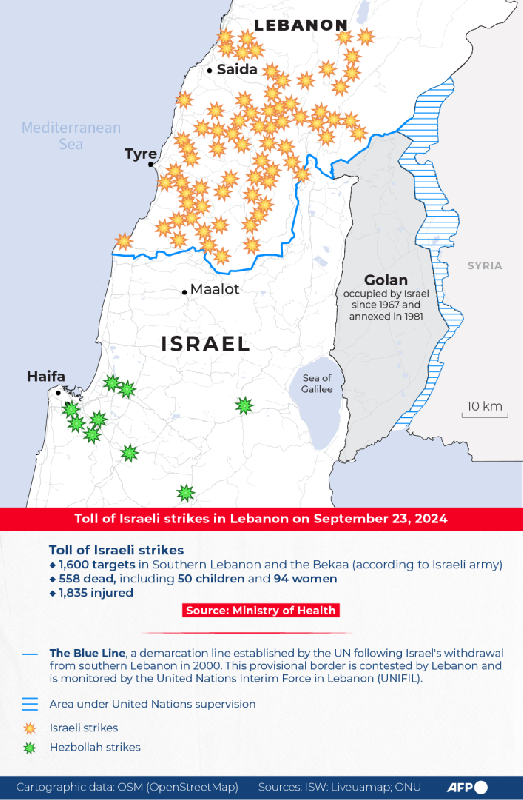- Home
- War in the Middle East
- September 23: Deadliest Israeli Operation Since Civil War

Code-named "Northern Arrows" by Israel, the September 23 aerial military operation against Lebanon was the deadliest since the end of the Civil War.
In a single day, Israeli airstrikes claimed 558 lives, including 35 children and 58 women, and left 1,835 wounded, according to the Ministry of Health's latest report, released on Tuesday.
The Israeli army reported striking 1,600 Hezbollah targets in southern Lebanon and the Beqaa Valley, continuing its assault late into Monday night.
Initially concentrated in the South and the Beqaa, with sporadic strikes on the southern suburbs of Beirut, Israeli airstrikes expanded to new areas across Lebanon on Monday.
Israeli rockets hit mountainous regions in Keserwan (Qartaba, Mayrouba) and Jbeil (Ehmej, Laqlouq). Since these areas are uninhabited, no casualties were reported.

Caretaker Health Minister Firass Abiad labeled the day “the deadliest since the beginning of the conflict,” highlighting that 27 hospitals across the country were overwhelmed by a surge of injured people exceeding their capacity.
On the international front, United Nations Secretary-General Antonio Guterres expressed “serious concern” over the high number of civilian victims in Lebanon, according to his spokesperson.
“We are on the brink of a full-scale war,” warned Josep Borrell, the European Union's foreign policy chief.
What makes the September 23 Israeli offensives particularly alarming? How do they compare to previous operations in scale?
An unmatched scale
The most recent conflict with Israel was the 33-Day War between Hezbollah and the Israeli army from July 12 to August 14, 2006.
This conflict was ignited by a border incident, in which Hezbollah kidnapped two Israeli soldiers, prompting Israel to launch a military offensive that devastated much of Lebanon’s infrastructure. Key targets included roads, bridges, airports, ports, factories and fuel depots.
Remarkably, the number of victims from the Israeli attacks on September 23, 2024, accounts for nearly half of the total deaths recorded during the 33 days of conflict in 2006, all in just one day.
Another significant event is the 1996 Israeli military operation known as “Operation Grapes of Wrath.” Over the course of 16 days, Israel conducted 1,100 airstrikes, equivalent to the total number of strikes carried out on September 23.
This operation was marked by the tragic massacre in Qana on April 18, 1996, recognized as one of the most significant artillery strikes of the 20th century within military circles. On that day, Israeli artillery targeted a UN compound in Qana, a village in the Tyre district, where approximately 800 individuals had taken refuge. The attack resulted in the deaths of 106 people. Multiplying this figure by five yields the death toll from the September 23 strikes.

In 2006, General Dan Halutz, then the Israeli army’s Chief of Staff, vowed to “set Lebanon back fifty years.”
In light of the September 23 events, one might now ponder what the equivalent threat in 2024 could be.
In a single day, Israeli airstrikes claimed 558 lives, including 35 children and 58 women, and left 1,835 wounded, according to the Ministry of Health's latest report, released on Tuesday.
The Israeli army reported striking 1,600 Hezbollah targets in southern Lebanon and the Beqaa Valley, continuing its assault late into Monday night.
Initially concentrated in the South and the Beqaa, with sporadic strikes on the southern suburbs of Beirut, Israeli airstrikes expanded to new areas across Lebanon on Monday.
Israeli rockets hit mountainous regions in Keserwan (Qartaba, Mayrouba) and Jbeil (Ehmej, Laqlouq). Since these areas are uninhabited, no casualties were reported.

Caretaker Health Minister Firass Abiad labeled the day “the deadliest since the beginning of the conflict,” highlighting that 27 hospitals across the country were overwhelmed by a surge of injured people exceeding their capacity.
On the international front, United Nations Secretary-General Antonio Guterres expressed “serious concern” over the high number of civilian victims in Lebanon, according to his spokesperson.
“We are on the brink of a full-scale war,” warned Josep Borrell, the European Union's foreign policy chief.
What makes the September 23 Israeli offensives particularly alarming? How do they compare to previous operations in scale?
An unmatched scale
The most recent conflict with Israel was the 33-Day War between Hezbollah and the Israeli army from July 12 to August 14, 2006.
This conflict was ignited by a border incident, in which Hezbollah kidnapped two Israeli soldiers, prompting Israel to launch a military offensive that devastated much of Lebanon’s infrastructure. Key targets included roads, bridges, airports, ports, factories and fuel depots.
Remarkably, the number of victims from the Israeli attacks on September 23, 2024, accounts for nearly half of the total deaths recorded during the 33 days of conflict in 2006, all in just one day.
Another significant event is the 1996 Israeli military operation known as “Operation Grapes of Wrath.” Over the course of 16 days, Israel conducted 1,100 airstrikes, equivalent to the total number of strikes carried out on September 23.
This operation was marked by the tragic massacre in Qana on April 18, 1996, recognized as one of the most significant artillery strikes of the 20th century within military circles. On that day, Israeli artillery targeted a UN compound in Qana, a village in the Tyre district, where approximately 800 individuals had taken refuge. The attack resulted in the deaths of 106 people. Multiplying this figure by five yields the death toll from the September 23 strikes.

In 2006, General Dan Halutz, then the Israeli army’s Chief of Staff, vowed to “set Lebanon back fifty years.”
In light of the September 23 events, one might now ponder what the equivalent threat in 2024 could be.
Read more




Comments